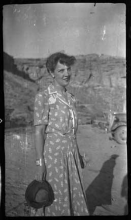Article
Florence Hawley Ellis was a Southwestern archaeologist, who was not only a pioneer of dendrochronology, a method of dating using tree rings, but also accomplished the first chemical analysis of black pigments used on Southwestern ceramics. She received her degrees from the University of Arizona and the University of Chicago during the Great Depression, a time when it was very difficult for anyone to be funded through school, especially a woman. She then was then recommended by Clyde Kluckhohn for a position at UNM as a professor of archaeology. She taught at UNM from 1934 until her retirement in 1971. She was also very interested in Pueblo prehistory and was involved in working with Pueblo communities who were in the midst of land disputes.
"Archaeologist Florence Hawley Ellis, Chaco Canyon, New Mexico, 1940," photograph by Armand G. Winfield. (155545). Palace of the Governors, New Mexico History Museum.
Manuscripts
References
Parezo, Nancy J.
1993 Hidden Scholars: Women Anthropologists and the Native American Southwest.
Albuquerque: University of New Mexico Press.

